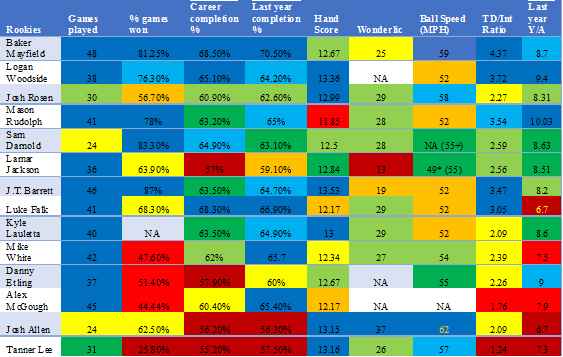AugustUpdate Camp News |
Staff Rankings
| Config Cheat Sheet
| STOMP
Draft Strategies | Depth Charts | Mock Drafts | SOS | Tools | ADP
Diehards Staff Experts Poll | Draft Simulator | University Videos
Draft Strategies | Depth Charts | Mock Drafts | SOS | Tools | ADP
Diehards Staff Experts Poll | Draft Simulator | University Videos
What The Numbers Say About Success And Failure For Quarterbacks Pt 4 Rookie Projections
By Adam Hall

The Annual Question
Every year the same question is on the lips of all football fans, which quarterback is going to be the talk of the league this year. Thankfully the model discussed in the past three articles has much to make everyone feel comfortable with any claim under the sun. Each player is a mosaic filled with pieces of data that point us in one direction or another. This article will analyze many of the major quarterbacks to come out of college this year with an emphasis on prospects for future success, and failure. Although all the first-round prospects will get attention, this article primarily focuses on those with the most potential to succeed and bust.
Superstar Potential
• Baker Mayfield
Baker Mayfield is the fourth rated quarterback in the entirety of the model (1. Andrew Luck, 2. Marcus Mariota, 3. Tim Tebow). Mayfield is in great company with QBs like: Ben Roethlisberger, Russell Wilson, Aaron Rodgers, Phillip Rivers, and Cam Newton ending up ranked just behind him. Don’t let the Tim Tebow appearance scare you away from investing in Mayfield, here are his numbers to assuage any concerns:

Baker has everything that you would want in a QB coming out of school, he has immense experience, and has overcome obstacle after obstacle to become the first overall pick in the draft. More so than any other quarterback in the NFL not named Tom Brady, Mayfield has demonstrated the crucial element of grit. This is when someone has to overcome intense adversity, they are left much stronger and successful person after the ordeal is complete. Mayfield walked on at Texas Tech and won, then he walked on at Oklahoma and won, then he marched into Ohio State’s stadium and won. Players like Tom Brady and Aaron Rodgers had to overcome different difficulties to become who they are today, while players like Paxton Lynch were handed their positions and turned them into nothing. Mayfield has had to rip every opportunity away from someone else, and that continues to today, he will be stronger for it.
The experts at Profootballfocus.com (PFF) agree with this assessment. Since they have begun charting college football nearly five years ago, Mayfield is their top ranked QB. During his career, he has earned three of their top seven quarterback ratings. For every metric of import, Mayfield is at the top of the charts: QBR under pressure, QBR in a clean pocket, completion on intermediate routes, and passes that travelled more than 20 yards down field. Every metric that you want to see in your QB, Mayfield has it in droves.
According to PFF, the single most stable metric for a quarterback is their performance from a clean pocket, the following graphics demonstrate that Mayfield’s success is not a statistical aberration.
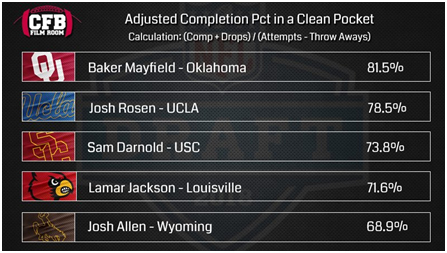
Last season, 94% of all pass attempts in the NFL traveled between 0-19 yards downfield

Finally, if Mayfield’s Wonderlic score seems problematic, it isn’t. Mayfield like all other incoming quarterbacks took a modernized version of the Wonderlic called the Athletic Intelligent Quotient test (AIQ) and received the second highest score since 2012. Unfortunately, this metric is not leaked to the public or it would have been the staple for this model. This score speaks to his speed of processing, and critical thinking ability. With this entire picture now present, it becomes plain to see, draft Baker Mayfield in every dynasty league, even if the team is overflowing at quarterback.
High End Starters
• Josh Rosen
• Mason Rudolph
• Sam Darnold
• Lamar Jackson
Each of the following quarterbacks have the potential to be high end starters (top-15). Below are each of their scores:

Although diving deep into each of the players drafted in the first round goes beyond the scope of this article, one can see that none of the quarterbacks beyond Lamar Jackson have a single death knell statistic. Each of them have the requisite arm strength, completion percentage, hand size and last year Y/A to be successes in the NFL.
It would be neglectful to not address Lamar Jackson’s shortcomings. In a recent article from rotoballer.com, I address Lamar Jackson’s poor combine throwing results. In this article, I found that Lamar Jackson’s average fast-ball was much closer to 55 MPH than the 49MPH that he threw at the combine. Regardless of my previous statements pertaining to the racial bias associated with the Wonderlic, Jackson’s score of 13 is difficult to square. If Jackson was not the most impressive mobile quarterback since Michael Vick, this resume would be cause for concern, but what Jackson lacks in conventional methods, he makes up for in improvisation, and a more well-rounded game than often thought. Check out the link article for a thorough evaluation of Jackson’s arm strength and overall play.
Jackson is brought up to shine a light on a statistic that has largely been left out of the conversation about these players, the percentage of dropped balls each had to deal with. For example, Sam Darnold, Josh Allen, and Baker Mayfield had a combined 57 passes dropped by receivers in 2017, while Josh Rosen alone had 43.
As severe as that sounds, Lamar Jackson was even worse off. As depicted below, more than 12% of Jackson’s passes last year were dropped. If Jackson had an average drop rate, his completion percentage would have jumped to above 62%, and with it would have placed him in the above average category at the position. Fewer than 10% of players in college football last year had a higher percentage of their passes dropped than Jackson. Rosen’s supporting cast didn’t do him many favors either, with a horrendous 11% drop rate, fewer than 20% of quarterbacks dealt with a higher drop percentage than Rosen.
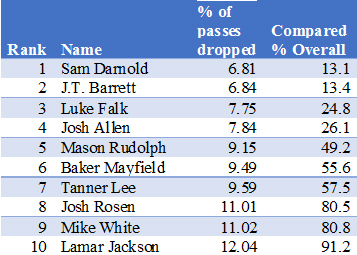
The tie-breaker between Darnold and Rosen in this model was the higher physical (arm strength, hand score), and mental upside that Rosen has demonstrated through the pre-draft process. Furthermore, Darnold consistently benefitted from a solid supporting cast. Darnold’s receiving options blessed him with a fantastic 6.81 drop percentage which was better than nearly 87% of the quarterbacks in the sample analyzed (60 national level QBs). Given a scenario where regression to the mean comes into play, it becomes clear that Rosen is the more dependable quarterback that checks more of the boxes that an analyst would care to see.
After looking over all the pertinent variables, Josh Rosen is the second rated quarterback in the 2018 class.
Long Term Backups
• J.T. Barrett
• Kyle Lauletta
• Mike White
Each of these players have enough on their resumes to justify long term backup positions in the NFL; but due to a variety of lacking characteristics, it is unlikely they will ever earn a starting position.
BUSTS
• Luke Falk
Although Luke Falk has an overall impressive resume, as he has a great overall completion percentage, he has a 3.0+ TD/INT ratio, and played in more than 40 games, the rest of his numbers are concerning to say the least. With a hand score barely above 12, a ball speed score at 52, and worst of all a Y/A of 6.7, history is heavily slanted against his chances of success.
• Tanner Lee
It takes a lot to be a worse prospect than Josh Allen when it comes to production, yet Tanner Lee found a way. Lee is in the bottom 1% of the entire model and should be kept away from like the plague.
• Josh Allen
To put it bluntly, no quarterback drafted since 2001 has been a success with a resume that looks anything like what Josh Allen has put on tape.
The Numbers:
Before any further context is given as to why Allen is the biggest looming bust in years, here are his numbers compared to several other infamous busts.

Needless to say, no one would want to be mentioned in the same breath as these three busts, but unfortunately, Josh Allen’s strongest pro-comparison is Kyle Boller.
The Context:
Returning to part 2 of this series, one can see that Allen triggers three of the four failure statistics. No quarterback drafted since 2008 has been successful (QBR of at least 64) with a last year yards per attempt average (Y/A) under 7.3, strike one. The incidence of a quarterback succeeding with a career completion percentage under 60% is quite rare, only four QBs since 2001 have overcome that deficit, and two of them are not regarded in the greatest way (Matt Ryan, Matthew Stafford, Colin Kaepernick, Tyrod Taylor), strike two. Finally, and most damning, his last year completion percentage is far under 58.5%. Literally no quarterback since 2001 has had a successful career with completion percentage under that benchmark, strike three, he's out.
Beyond the putrid marks on the most important aspects of the model, Allen only played 24 games in his college career. This speaks to his overall lack of development, and his need for further experience before he can be expected to shoulder the burden of an NFL franchise. Finally, his touchdown to interception ratio is extremely low for this era at a meager 2.09. There were no successful quarterbacks drafted in this decade that had that low of a TD/INT ratio. To add more context to this last metric, Allen’s coaches seemed to be so worried about his inconsistent arm that they had him pass 103 fewer passes his last year. This led to 12 fewer touchdown passes along with only 9 fewer interceptions. Overall, Allen’s production fell off a cliff in his last year, his yards per attempt dropped from 8.6 to 6.7. One of the marque trends of successful quarterbacks according to the model is continued positive progression during college, especially if the quarterback’s career completion percentage is likely going to be under 60%. Allen failed to develop after his first year starting in Wyoming, providing another proverbial nail in his coffin.
With such a live arm, one would expect Allen to have a higher Y/A, but when dissected further Allen was the worst deep ball thrower out of the first-round quarterbacks taken this year. Even Allen’s big arm can’t deliver what it’s billed as.
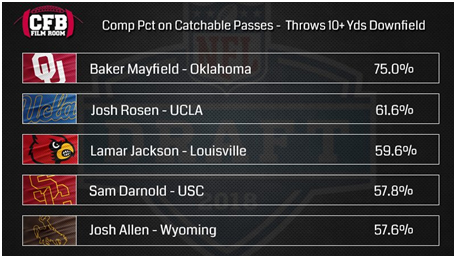
To overcome these deficits, Allen would have to break every trend in the NFL. In a league where defenses play in nickel sets more than 65% of the time, a successful quarterback needs to not only have a rocket arm but understand how to use it with a strong degree of consistent precision. Allen has never demonstrated the ability to maintain accuracy on any reliable scale. This lies at the heart of why he is almost certainly going to bust on the next level.
The Competition:
Against Power-5 opponents, Josh Allen would have had a higher QBR if he threw the ball at the ground every play. Let that sink in, Allen was so bad that it would have been better for his team, if he never got off the bus against a Power-5 opponent. Against teams with legitimate competition, he threw for a 50% completion rate, and more troubling, he threw 8 interceptions to only 1 touchdown. If one was hoping the story would be clearer against lesser competition, it wasn’t. Allen only threw for 300 or more yards twice in his 24 games, and that was against Nevada-Last Vegas University (which required a triple overtime to achieve), while the other was against a school called Gardner-Webb. One could be forgiven for never having heard of either one of these schools. This is Josh Allen in a nutshell, he’s absolutely putrid when the lights shine the brightest, and he’s barely serviceable against anyone but the lowest of competition. I have nothing against the man, but from everything Allen has shown, us he is the definition of a hollow marble sculpture, beautiful on the outside, but devoid of substance.
The excuses:
The biggest single excuse that Allen benefited from during the pre-draft process was his team at Wyoming. The predominant logic was that if Allen went to a better university, he would have performed better. This narrative goes on to say that Allen’s receiving options were bad across the board, and these individuals felt vindicated when Allen lost two offensive weapons last year and got worse. This is no excuse at all because Allen should have been able to develop into a better player with more experience against sub-par competition in his second year starting. If anything, he got worse in every metric but completion percentage (only a .3% increase on more than 100 fewer attempts making it a less reliable statistic).
Furthermore, the narrative that Allen’s receivers weren’t doing him any favors is bunk. Wyoming had one of the better drop rates in the nation at 7.84%, that puts Allen in the 26th percentile in the sample for overall drop rate, that’s far lower than average. Allen’s offensive line was very poor, but Allen is uniquely poised to ameliorate that issue with his mobility, but that didn’t help propel his production to even average levels.
Finally, this is not a new point of discussion, every year of Allen’s career he’s had a hard time completing balls. Coaches make it their highest priority to mentor and coach out problems like these; but even a 1.4 million dollar a year coach in Wyoming was unable to deal with Allen’s lingering issues. If Allen’s consistency issues were less constant there would be cause for optimism, but this isn’t an anomaly, it’s a hard-set characteristic and it seems no amount of coaching makes a difference.
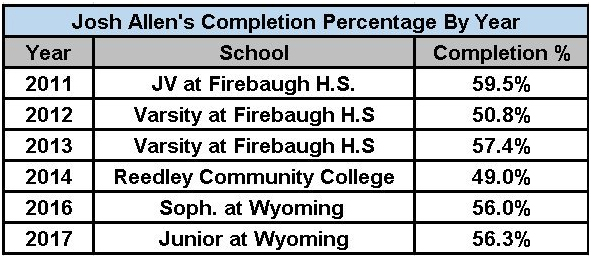
The Comparison:
Baker Mayfield and Josh Allen are diametrically opposed athletes. Mayfield tops the charts in passer efficiency regardless of situation, he’s poised, and laser focused. Josh Allen is his opposite, he is erratic, often opting to run instead of pass and is consistently represented at the bottom of the accuracy metrics. Mayfield may not be the pure physical specimen or overall athlete that Allen is, but he doesn’t need to be to do what he does best.
The two quarterbacks up until now can be summed up by one play from each of their pre-season games this last week. For Allen, the play is an aggressive overthrow of an open receiver. While for Mayfield, he has to make an opportunity when it has been taken from him, rolling to his right, he floats the ball perfectly to his receiver just far enough in for Callaway to make the impressive catch.
When making the choice in a fantasy league this year, don’t overthink the decision, take Baker Mayfield and smile as he produces for years to come.
Numbers For All Notable Rookies, 2018
